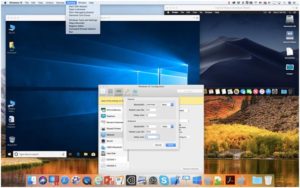
- #PARALLELS DESKTOP FOR MAC LATEST VERSION HOW TO#
- #PARALLELS DESKTOP FOR MAC LATEST VERSION FOR MAC#
- #PARALLELS DESKTOP FOR MAC LATEST VERSION MAC OS#
- #PARALLELS DESKTOP FOR MAC LATEST VERSION FULL#
- #PARALLELS DESKTOP FOR MAC LATEST VERSION SOFTWARE#
With the M1 Ultra in the Mac Studio, Parallels Desktop 18 "delivers up to 96% faster Windows 11" performance compared to previous versions of Parallels.įull support for Apple's ProMotion display with automatic refresh rate changes and unleashed Apple M1 Ultra performance allowing users to assign more resources and get up to 96% faster Windows 11.
#PARALLELS DESKTOP FOR MAC LATEST VERSION FULL#
Parallels Desktop 18 is designed to take full advantage of the latest Mac hardware, including the highest-end M1 Ultra Apple silicon chip.
#PARALLELS DESKTOP FOR MAC LATEST VERSION FOR MAC#
Though Parallels automatically compresses virtual disks, you'll need hard-drive space available for both the host and the guest OSes.Parallels for Mac has announced Parallels Desktop 18, a new update that brings full support for the ProMotion displays in the 14-inch and 16-inch MacBook Pros, improved performance on the M1 Ultra chip, easier Windows 11 setup, and more. The price of admission for a smooth virtual Windows 7 environment starts at a new dual-core CPU and at least 4 gigabytes of RAM, coupled with a decent graphics processor for the Windows Aero effects. System requirements needed to achieve the full experience with Parallels are on the upper end. Overall, the stability and usability of Parallels is something that every IT team can appreciate.
#PARALLELS DESKTOP FOR MAC LATEST VERSION HOW TO#
This means there's no user confusion about which program will be needed to open which file, or how to make it happen Parallels takes care of it automatically.Īs a final note, the migration tool built into Parallels significantly reduces the overhead for IT departments when transferring users from a PC to a Mac.
#PARALLELS DESKTOP FOR MAC LATEST VERSION MAC OS#
Parallels has also made great strides in seamlessly sharing files between operating systems, so much so that the Mac OS will set file types that open only in Windows to default as such. Now, with only Coherence mode available (the Crystal features have been added), users can be assured of the best possible Windows experience on a Mac. These types of integration between the Mac and Windows operating systems were separate options in the past, adding to the confusion of which would offer a better experience for the end user. The most important advancement of interest to IT departments is the combination of Crystal and Coherence modes. Combine that with the speed of ÂParallels, and the seemingly impossible becomes possible for any type of user. Why It Works For ITīlending the security and stability of OS X with the compatibility of Windows ranks high on any IT department's wish list. Windows 7 resumes in less than 10 seconds, and applications - whether 3D or not - run at near-native speed to a Boot Camp partition. In addition, the increased speed of Parallels 6 will astound any user. When a device is inserted, a user-friendly window appears and asks which OS the user would like to connect to, then Parallels takes care of the rest. Once the virtual machine setup is complete, Parallels accepts almost any external device. Parallels Tools automatically loads, thus enabling 3D support, mouse synchronization and seamless drag-and-drop. There's a fully automated express-Âinstall feature, as well as a tool to create a virtual machine entirely from an existing PC, so there is no need to reinstall programs and reconfigure settings. During the installation process, the product carefully explains menu choices and uses diagrams to show the user which selections affect which settings.

#PARALLELS DESKTOP FOR MAC LATEST VERSION SOFTWARE#
Parallels client virtualization software for running Windows apps on a Mac showcases what a seamless Mac and Windows environment can be, from installation to actual use.

That's all changed with the release of Parallels Desktop 6 for Mac. Virtualization promised to reduce the hassle of switching, but interfaces were clunky and performance was lacking. Add to this the mystery of peripheral support, and it's no surprise that users avoided Macs when PC software was needed. Among the PC applications that were available for the Mac platform, some didn't work like their Windows counterparts, some weren't updated as often, and some simply didn't work at all. Transitioning from a PC to a Mac used to be an exercise in compromises.


 0 kommentar(er)
0 kommentar(er)
